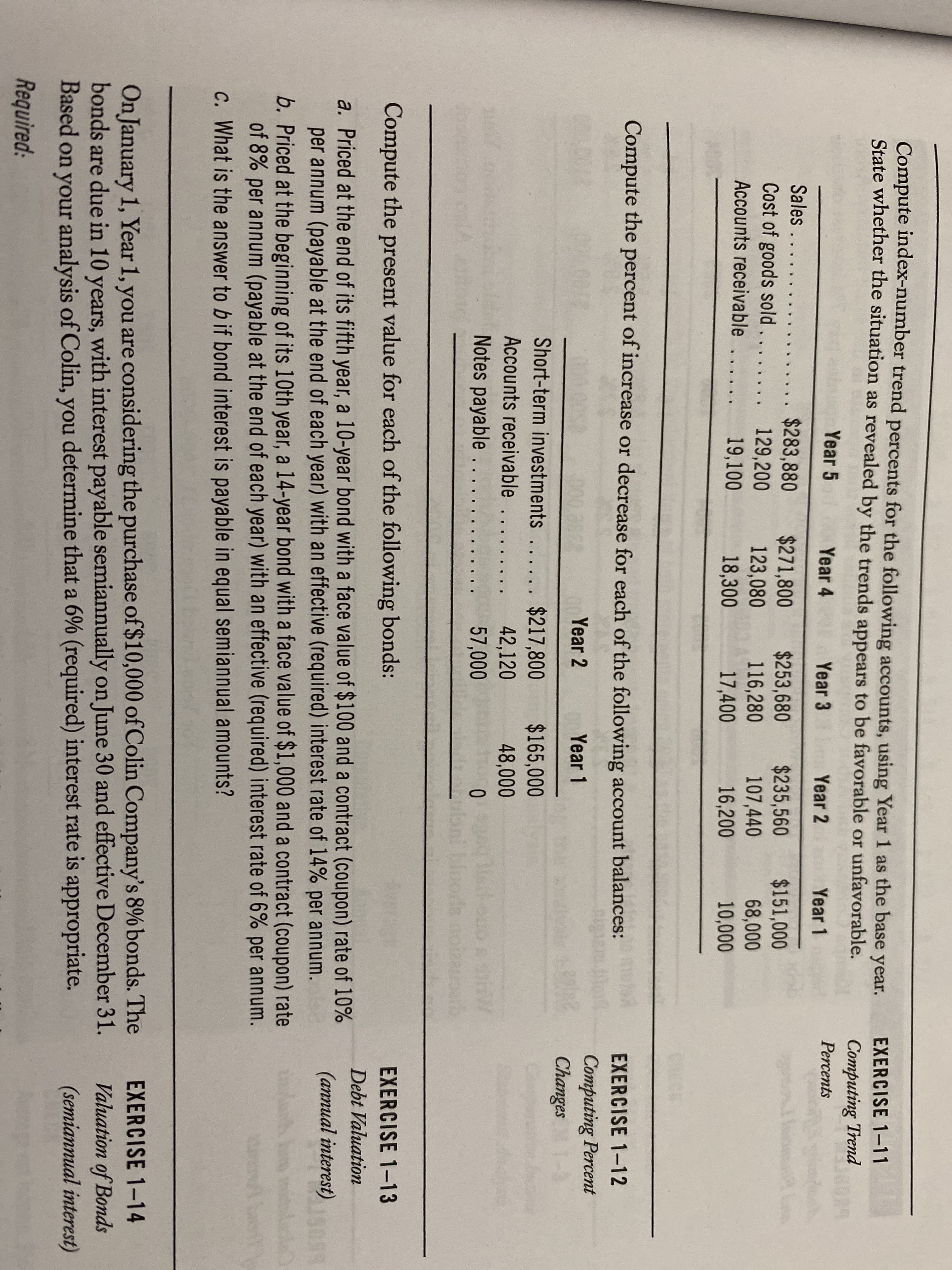Compute the present value for each of the following bonds: a. Priced at the end of its fifth year, a 10-year bond with a face value of $100 and a contract (coupon) rate of 10% per annum (payable at the end of each year) with an effective (required) interest rate of 14% per annum. b. Priced at the beginning of its 10th year, a 14-year bond with a face value of $1,000 and a contract (coupon) rate of 8% per annum (payable at the end of each year) with an effective (required) interest rate of 6% per annum. C. What is the answer to b if bond interest is payable in equal semiannual amounts?
Compute the present value for each of the following bonds: a. Priced at the end of its fifth year, a 10-year bond with a face value of $100 and a contract (coupon) rate of 10% per annum (payable at the end of each year) with an effective (required) interest rate of 14% per annum. b. Priced at the beginning of its 10th year, a 14-year bond with a face value of $1,000 and a contract (coupon) rate of 8% per annum (payable at the end of each year) with an effective (required) interest rate of 6% per annum. C. What is the answer to b if bond interest is payable in equal semiannual amounts?
Cornerstones of Financial Accounting
4th Edition
ISBN:9781337690881
Author:Jay Rich, Jeff Jones
Publisher:Jay Rich, Jeff Jones
Chapter10: Stockholder's Equity
Section: Chapter Questions
Problem 88PSA: Ratio Analysis Consider the following information taken from the stockholders equity section: How do...
Related questions
Question
1-13 all parts

Transcribed Image Text:Compute index-number trend percents for the following accounts, using Year 1 as the base year.
State whether the situation as revealed by the trends appears to be favorable or unfavorable.
EXERCISE 1-11
Computing Trend
Year 5
Year 4
Year 3
Year 2
Year 1
Percents
Sales......
$283,880
129,200
19,100
$271,800
123,080
18,300
$253,680
116,280
17,400
$235,560
$151,000
68,000
10,000
Cost of goods sold...
107,440
16,200
Accounts receivable
CRECK
Compute the percent of increase or decrease for each of the following account balances:
EXERCISE 1-12
Year 2
Year 1
Computing Percent
Changes
1-3
Short-term investments ...... $217,800
Accounts receivable ....
Notes payable ....
$165,000
42,120
57,000
48,000
Compute the present value for each of the following bonds:
EXERCISE 1-13
Debt Valuation
a. Priced at the end of its fifth year, a 10-year bond with a face value of $100 and a contract (coupon) rate of 10%
per annum (payable at the end of each year) with an effective (required) interest rate of 14% per annum.
b. Priced at the beginning of its 10th year, a 14-year bond with a face value of $1,000 and a contract (coupon) rate
of 8% per annum (payable at the end of each year) with an effective (required) interest rate of 6% per annum.
c. What is the answer to b if bond interest is payable in equal semiannual amounts?
(annual interest)
On January 1, Year 1, you are considering the purchase of $10,000 of Colin Company's 8% bonds. The
bonds are due in 10 years, with interest payable semiannually on June 30 and effective December 31.
Based on your analysis of Colin, you determine that a 6% (required) interest rate is appropriate.
EXERCISE 1-14
Valuation of Bonds
(semiannual interest)
Required:
Expert Solution
Step 1
A bond is a financial instrument issued by large business organizations and governments to raise debt funds for a long-term period. The issuer of a bond shall be liable to pay periodic coupon payments as per the agreed coupon rate.
The intrinsic value of a financial instrument represents a sum of the present value of future cash flows expected from that instrument. Therefore, the bond price at any given time represents a sum of present value of future cash flows expected from the bond.
Trending now
This is a popular solution!
Step by step
Solved in 2 steps with 1 images

Knowledge Booster
Learn more about
Need a deep-dive on the concept behind this application? Look no further. Learn more about this topic, finance and related others by exploring similar questions and additional content below.Recommended textbooks for you

Cornerstones of Financial Accounting
Accounting
ISBN:
9781337690881
Author:
Jay Rich, Jeff Jones
Publisher:
Cengage Learning


Survey of Accounting (Accounting I)
Accounting
ISBN:
9781305961883
Author:
Carl Warren
Publisher:
Cengage Learning

Cornerstones of Financial Accounting
Accounting
ISBN:
9781337690881
Author:
Jay Rich, Jeff Jones
Publisher:
Cengage Learning


Survey of Accounting (Accounting I)
Accounting
ISBN:
9781305961883
Author:
Carl Warren
Publisher:
Cengage Learning

Financial Reporting, Financial Statement Analysis…
Finance
ISBN:
9781285190907
Author:
James M. Wahlen, Stephen P. Baginski, Mark Bradshaw
Publisher:
Cengage Learning